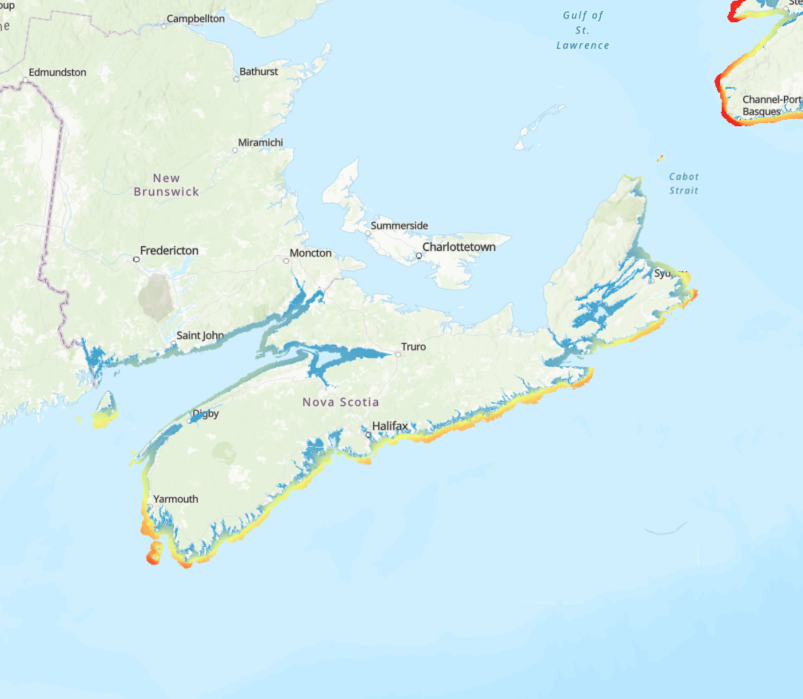Bay of Fundy
Type of resources
Topics
Keywords
Contact for the resource
Provided by
Formats
Representation types
Update frequencies
status
-
The data layer (.shp) presented is the result of an unsupervised classification method for classifying seafloor habitat in the Bay of Fundy (Northwest Atlantic, Canada). This method involves separating environmental variables derived from multibeam bathymetry (slope, bathymetric position index), backscatter, and oceanographic information (wave-shear current velocity) into spatial units (i.e. image objects) and classifying the acoustically and oceanographically separated units into 7 habitat classes (Bedrock and Boulders, Mixed Sediments, Gravelly Sand, Sand, Silty Gravel with Anemones, Silt, and Tidal Scoured Mixed Sediments) using in-situ data (imagery). Benthoscape classes (synonymous to landscape classifications in terrestrial ecology) describe the geomorphology and biology of the seafloor and are derived from elements of the seafloor that were acoustically and oceanographically distinguishable. Reference: Wilson, B.R., Brown, C.J., Sameoto, J.A., Lacharite, M., Redden, A. (2021). Mapping seafloor habitats in the Bay of Fundy to assess macrofaunal assemblages associated with Modiolus modiolus beds. Estuarine, Coastal and Shelf Science, 252. https://doi.org/10.1016/j.ecss.2021.107294 Cite this data as: Wilson, B.R., Brown, C.J., Sameoto, J.A., Lacharite, M., Redden, A. Bay of Fundy Benthoscape. Published May 2023. Population Ecology Division, Fisheries and Oceans Canada, Dartmouth, N.S. https://open.canada.ca/data/en/dataset/dbabd17a-a2c7-4b3f-9bd8-a77a9c7f9c1c
-

Exposure to wind-driven waves forms a key physical gradient in nearshore environments influencing both ecological communities and human activities. We calculated a relative exposure index (REI) for wind-driven waves covering the coastal zone of the Scotian Shelf-Bay of Fundy bioregion. We derived REI and two other fetch-based indices (sum fetch, minimum fetch) from two formulations of wind fetch (unweighted and effective fetch) for input points in an evenly spaced fishnet grid (50-m resolution) covering a buffered area within 5 km from the coastline and shallower than 50 m depth. We calculated unweighted fetch lengths (m) for 32 compass headings per input point (11.25° intervals), and effective fetch lengths for 8 headings per point (45° intervals). Unweighted fetch is the distance along a given heading from a point in coastal waters to land. Effective fetch is a directionally weighted average of multiple fetch measures around a given heading that reduces the influence of irregular coastline shape on exposure estimates. For fetch calculations, we used land features at a 1:50,000 scale for Canadian administrative boundaries (NrCan 2017), and unknown resolution for St. Pierre and Miquelon, and US states bordering the Gulf of Maine (GADM 2012). The summed and minimum unweighted fetch lengths for each point provide coarse summaries of wave exposure and distance to land, respectively. The relative exposure index (REI) gives a more accurate metric of exposure by combining effective fetch with modelled wind speeds (m s-1) and frequency data. We provide the original calculations of unweighted fetch, effective fetch, and other fetch-based indices (i.e., sum, minimum) in csv format along with the REI layer (GeoTIFF format) resampled to 35-m resolution. With broad spatial coverage and high resolution, these indices can support regional-scale distribution modelling of species and biological assemblages in the coastal zone as well as marine spatial planning activities. When using data please cite following: O'Brien JM, Wong MC, Stanley RRE (2022) A relative wave exposure index for the coastal zone of the Scotian Shelf-Bay of Fundy Bioregion. figshare. Collection. https://doi.org/10.6084/m9.figshare.c.5433567 References GADM database of Global Administrative Areas (2012). Global Administrative Areas, version 2.0. (accessed 2 December 2020). www.gadm.org Natural Resources Canada (2017) Administrative Boundaries in Canada - CanVec Series - Administrative Features - Open Government Portal. (accessed 2 December 2020). https://open.canada.ca/data/en/dataset/306e5004-534b-4110-9feb-58e3a5c3fd97.
-

Exposure to wind-driven waves manifests an important physical gradient in the coastal zone that influences a variety of physical and biological processes (i.e., species distribution). Fetch, the unobstructed distance over which wind-driven waves can build, is a popular proxy for wave exposure at a given location commonly used for site-specific evaluations. Here, we provide two measures of fetch (unweighted fetch, effective fetch) and three fetch-derived indices of wave exposure (sum fetch, minimum fetch, and a relative exposure index) covering the coastal zones of two Canadian bioregions (Scotian Shelf-Bay of Fundy, Newfoundland-Labrador Shelves). For each region, we calculated fetch and exposure indices for input points in an evenly spaced fishnet grid (see linked records below for datasets by region). We provide unweighted fetch lengths (m) for 32 compass headings per input point (11.25° intervals), and effective fetch lengths for 8 headings per point (45° intervals). Effective fetch is a weighted average of multiple fetch measures around a given heading that reduces the influence of irregular coastline shape on exposure estimates. We also include calculations of the summed and minimum unweighted fetch lengths for each point that provide coarse proxies of exposure and distance to land, respectively. The relative exposure index (REI), provided as regional spatial layers in raster format, provides a more accurate metric of exposure by combining effective fetch with modelled wind speeds (m s-1) and frequency data. Users may also use fetch calculations to derive their own exposure layers using alternative sources of wind data, indices, or formulations. Detailed methodology on the calculations for fetch, effective fetch and REI are outlined in the Supplementary Information below. Citation information and differences in data pre-processing methods and spatial resolution of the regional analyses are described in their respective data records. The broad spatial coverage and high resolution offered by these indices are suitable to support regional-scale modelling and planning exercises. In particular, these indices will be of value to ongoing Marine Spatial Planning efforts, which includes regional conservation planning, that seek to evaluate the distribution of coastal species and overlap with human activities.
 Arctic SDI catalogue
Arctic SDI catalogue